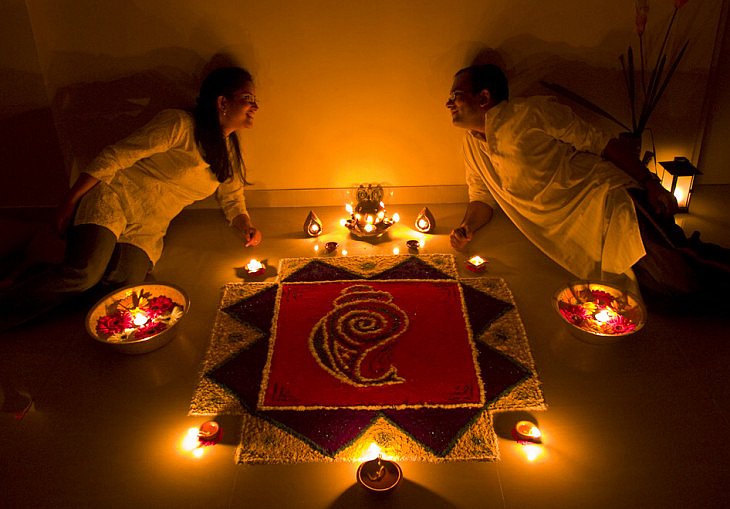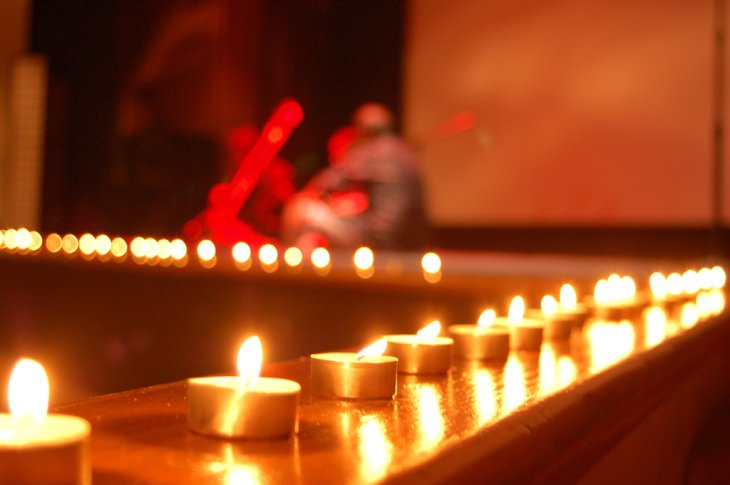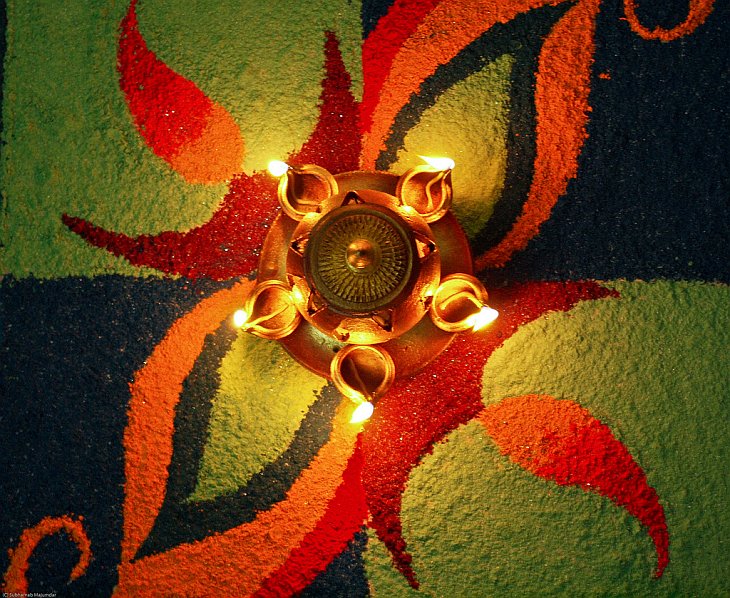
Deepavali (also: Depawali, Dipavali, Dewali, Diwali, Divali, Dipotsavi, Dipapratipad ) marks the beginning of the Hindu New Year according to the Lunar Calendar. It literally translated means 'Row of Lights' (from Sanskrit: dipa = lamp / awali = row, line). It celebrates the victory of Goodness over Evil and Light over Darkness - it ushers in the new year. Especially for this event people are cleaning their houses and wear new clothes. Diwali is a 5 day festival as Dhanteras, Choti Diwali, Badi (Main) Diwali, Padwa and Bhaiduj. There are many different names for the days of Diwali in different regions of India (South & North India, East & West India) and in the different languages spoken in that regions (i.e. Hindi, Urdu, Telugu, Tamil, Gujarati, Bengali). During Deepavali people pray to Lakshmi, Goddess of wealth, light, prosperity and wisdom, but also to Ganesha, the 'Remover of Obstacles' and the 'Lord of Beginnings'.

Deepavali celebrations take place in many countries in the world. On the first day of the Diwali festival people pray and having a special breakfast made of many different foods. The Hindu Goddess Lakshmi's statue and images are carried through the streets in processions. There are various legends and stories associated with the Diwali festival. The story of Bali, Emergence of Laxmi, Krishna Narakasur Fight, Victory of Rama over Ravana and many more. Dipa Lights (also called Diwali Diyas, Kandils, Ghee Lamps or Parvati Ganesha Lamps) - made of clay, fueled with Oil from Coconuts, Mustard or Ghee (clarified butter), the wick made of cotton wool - are placed outside of houses, on floors and doorways. During Diwali festival, doorways are hung with torans of mango leaves and marigolds. Deepavali Melas are being enjoyed by Hindus, Sikhs, Jains & Buddhists alike. On the day of Deepavali people exchange gifts, bursting firecrackers, lighting fireworks, colourful sparklers & bonfires and having festive meals. Diwali Melas (fairs) are held throughout India and the celebrations abroad. The Indian Festival of Lights takes place after the monsoon season has finished and the weather is nice and pleasant again.
Wishing Happy Diwali to everyone! Deepavali Valthukkal!! Shubh Diwali!!

Deepavali celebrations take place in many countries in the world. On the first day of the Diwali festival people pray and having a special breakfast made of many different foods. The Hindu Goddess Lakshmi's statue and images are carried through the streets in processions. There are various legends and stories associated with the Diwali festival. The story of Bali, Emergence of Laxmi, Krishna Narakasur Fight, Victory of Rama over Ravana and many more. Dipa Lights (also called Diwali Diyas, Kandils, Ghee Lamps or Parvati Ganesha Lamps) - made of clay, fueled with Oil from Coconuts, Mustard or Ghee (clarified butter), the wick made of cotton wool - are placed outside of houses, on floors and doorways. During Diwali festival, doorways are hung with torans of mango leaves and marigolds. Deepavali Melas are being enjoyed by Hindus, Sikhs, Jains & Buddhists alike. On the day of Deepavali people exchange gifts, bursting firecrackers, lighting fireworks, colourful sparklers & bonfires and having festive meals. Diwali Melas (fairs) are held throughout India and the celebrations abroad. The Indian Festival of Lights takes place after the monsoon season has finished and the weather is nice and pleasant again.
Wishing Happy Diwali to everyone! Deepavali Valthukkal!! Shubh Diwali!!

| What's the difference between Deepavali vs. Diwali ? | ||
|---|---|---|
| DEEPAVALI | DIWALI | |
| Origin | Deepavali is the ORIGINAL NAME from Sanskrit Dīpāvalī (दीपावली) meaning "Row of Lamps" or "Spreading of Light". | Contraction of the word "Deepavali". Could have emerged to simplify pronunciation especially under the British rule (1757-1947). |
| Regional Significance | Celebrated in South-India in the states: Tamil Nadu, Kerala, Karnataka, Goa, Andhra Pradesh, Maharashtra Countries and Regions with a significant population of Indians from the southern Indian states (Tamils) such as: Malaysia, Singapore, Sri Lanka/Ceylon, Fiji, Guyana, Trinidad and Tobago, South Africa, Mauritius, Réunion, Martinique & Guadeloupe | Celebrated in North-India in the states: Gujarat, Madhya Pradesh, Chhattisgarh, Orissa, Rajasthan, Uttar Pradesh, Haryana, Punjab, Uttarakhand, Himachal Pradesh, Jammu & Kashmir, Bihar, Jharkhand, West Bengal, Sikkim, Meghalaya, Assam, Arunachal Pradesh, Nagaland, Manipur, Mizoram, Tripura Countries with a significant Indian population mainly from North-India such as: USA, Canada, United Kingdom and others (see below) |
| Date Calculation | Falls on Ashvina Krishna Chaturdasi (the lunar day before the new moon). The exact date is calculated based on the last 90 minutes before sunrise (Arunodaya). Deepavali involves bathing before sunrise. Geographic location: Chennai (Tamil Nadu) | Falls on the following lunar day on Ashvina Amavasya (lunar day of new moon). The date is calculated based on extended Pradosha (a few hours after sunset). Observed by displaying diyas, lanterns and firecrackers. Geographic location: Allahabad (Uttar Pradesh) |
| The 2 holidays are defined to occur on 2 separate lunar days. In the Gregorian (Western) Calendar, Deepavali & Diwali can fall on the same calendar day when both periods (see above) of about 16 hours in total happen to be within the 24 hours of a single civil/Gregorian day. This means that the date will fall in about 2/3 of cases (years) on the same Gregorian day. (Many thanks to Olivier Beltrami for his expert advice on this !) | ||
| Festival Days & Spiritual Differences | Deepavali is a 4 day festival Day 1: Deepavali (Naraka Chaturdasi) Commemorates the victory of Lord Krishna over the demon Naraka. People taking a bath in the early morning before sunrise while the stars are still shining in the sky. Day 2: Lakshmi Puja Goddess Lakshmi emerged from Kshira Sagara (Ocean of Milk). Lakshmi Pooja is performed on this day. Day 3: Kartika Shuddha Padwa/Bali Padyami Celebrates the victory of god Vishnu in his dwarf incarnation Vamana over the daemon king Bali. Honours Bali's return to earth for his devotion to the Lord and for his noble deeds to his people. First day of the Hindu month Kartika. Day 4: Yama Dvitiya Yama (God of Death) had a feast with his sister Yami. She put an auspicious tilak mark on his forehead for his well-being. On this day sisters pray for well-being of their brothers. In return brothers giving gifts to their sisters. | Diwali is a 5 day festival Day 1: Dhanteras Commemorates the birth of Dhanvantari (the physician of the Gods). Dhan translates to wealth. Goddess Lakshmi is being worshiped for prosperity and well-being. Many Indian businesses start their accounting year on this day. Day 2: Choti Diwali (Kali Chaudas) Also known as Small Diwali. Daemon Narakasura was killed by Krishna. Poojas for Lakshmi and Rama. Day 3: Diwali & Lakshmi Puja Commemorates the return of Lord Rama (King of Ayodhya) to his hometown from 14 years of exile in the forest, after defeating the evil daemon king Ravana of Lanka. Goddess Lakshmi emerged from Kshira Sagara (Ocean of Milk). Lakshmi Pooja is performed on this day. Day 4: Govardhan Puja (Annakoot) Celebrates the victory of Krishna over Indra, the deity of thunder and rain, by lifting Govardhana Hill with his little finger to save people from the floods. This day is also known as Annakoot (mountain of food). Day 5: Bhai Dhooj Sisters pray for well-being of their brothers and put a mark on their foreheads. Brothers give gifts to their sisters in return. |

Beautiful Rangoli with Diya Lights (Indian Candles)
Romantic Diwali